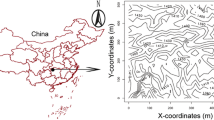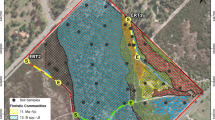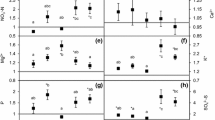Abstract
We assessed the effects of landscape features (vegetation type and topography), season, and spatial hierarchy on the nutrient content of surface soils in the Luquillo Experimental Forest (LEF) of Puerto Rico. Considerable spatial variation characterized the soils of the LEF, and differences between replicate sites within each combination of vegetation type (tabonuco vs. palo colorado vs. dwarf vs. pasture) and topographic position (ridge vs valley) accounted for 11–60% of the total variation in soil properties. Nevertheless, mean soil properties differed significantly among vegetation types, between topographic positions, and between seasons (wet vs dry). Differences among vegetation types reflected soil properties (e.g., bulk density, soil moisture, Na, P, C, N, S) that typically are related to biological processes and inputs of water. In forests, differences between topographic positions reflected elements (e.g., Ca, Mg, K, and Al) that typically are associated with geochemical processes; however, the nutrients and elements responsible for topographic differences in dwarf forest were different from those in other forest types. In pastures, differences between topographic positions were associated with the same soil properties responsible for differences among the other vegetation types. Pastures also had reduced N levels and different soil characteristics compared to undisturbed tabonuco forest. The only soil parameter that differed significantly between seasons was soil moisture. Soils of the LEF do not support the contention that N becomes limiting with an increase in elevation, and suggest that absolute pool sizes of N and P are not responsible for the reduction in productivity with elevation.
Similar content being viewed by others
References
Brown S, Lugo A E, Silander S and Liegel L 1983 Research history and opportunities in the Luquillo Experimental Forest. U.S.D.A. Forest Service, Southern Forest Experiment Station, General Technical Report SO-44.
Bruijnzeel L A and Proctor J 1995 Hydrology and biogeochemistry of tropical montane cloud forests: What do we really know? In Tropical Montane Cloud Forests: Proceedings of an International Symposium. Eds. L S Hamilton, J O Juvik and F N Scatena. pp 25–46. East-West Center, Honolulu, U.S.A.
Bruijnzeel L A and Veneklaas E J 1998 Climatic conditions and tropical montane forest productivity: The fog has not lifted yet. Ecology 79, 3–9.
Chapin F S III 1980 Mineral nutrition of wild plants. Ann. Rev. Ecol. Syst. 11, 233–260.
Detwiler R P and Hall C A S 1988 Tropical forests and the global carbon cycle. Science 239, 42–47.
Ewel J J and Whitmore J L 1973 The ecological life zones of Puerto Rico and the U.S. Virgin Islands. U. S. D. A. Forest Service. Institute of Tropical Forestry. Research Paper ITF-18. Rio Piedras, P.R.
Franklin J F, Bledsoe C S and Callahan J T 1990 Contributions of the Long-Term Ecological Research Program: An expanded network of scientists, sites, and programs can provide crucial comparative analyses. BioScience 40, 509–523.
Grubb P J 1971 Interpretation of the 'Massenerhebung Effect' on tropical mountains. Nature 229, 44–45.
Hunter A H 1982 International soil fertility and improvement: Laboratory procedures. Department of Soil Science, North Carolina State University. Raleigh, USA.
Hurlbert S H 1984 Pseudoreplication and the design of ecological field experiments. Ecol. Monogr. 54, 187–211.
Johnston M H 1992 Soil-vegetation relationships in a tabonuco forest community in the Luquillo Mountains of Puerto Rico. J. Trop. Ecol. 8, 253–263.
Lugo A E, Cuevas E and Sanchez M J 1990 Nutrients and mass in litter and top soil of ten tropical tree plantations. Plant Soil 215, 263–280.
Mathworks 1995 Matlab Reference guide. The MathWorks, Inc. Natick, USA.
Manly B F J 1994 Multivariate Statistical Methods: A Primer. Chapman & Hall, New York, USA. 215 p.
McDowell W H, Gines-Sanchez C, Asbury C E and Ramos-Perez C R 1990 Influence of seasalt aerosols and long range transport on precipitation chemistry at El Verde, Puerto Rico. Atmos. Environ. 24, 2813–2821.
Medina E, Cuevas E and Weaver P E 1981 Composición foliar y transpiracion de especies leñosas de Pico del Este, Sierra de Luquillo, Puerto Rico. Acta Cientifica Venezolana 32, 159–165.
Odum H T 1970 Rain forest structure and mineral-cycling homeostasis. In A Tropical Rain Forest, A Study of Irradiation and Ecology at El Verde, Puerto Rico. Eds. H T Odum and R F Pigeon. U. S. Atomic Energy Commission, Division of Technical Information, Oak Ridge, USA.
Rice W R 1989 Analyzing tables of statistical tests. Evolution 43, 223–225.
Scatena F N 1989 An introduction to the physiography and history of the Bisley Experimental Watersheds in the Luquillo Mountains of Puerto Rico. U. S. D. A. Forest Service, Southern Forest Experiment Station, General Technical Report SO-72.
Scatena F N and Lugo A E 1995 Geomorphology, disturbance, and the soil and vegetation of two subtropical wet steepland watersheds of Puerto Rico. Geomorphology 13, 199–213.
Seiders V M 1971 Geologic map of the El Yunque Quadrangle, Puerto Rico. U. S. Geological Survey. Miscellaneous Geological Investigations Map I-658.
Silver W L and Vogt K A 1993 Fine root dynamics following single and multiple disturbances in a subtropical wet forest ecosystem. J. Ecol. 81, 729–738.
Silver W L, Scatena F N, Johnson A H, Siccama T G and Sanchez M J 1994 Nutrient availability in a montane wet tropical forest: Spatial patterns and methodological considerations. Plant and Soil 164, 129–148.
Silver W L, Lugo A E and Keller M 1999 Soil oxygen availability and biogeochemistry along rainfall and topographic gradients in upland wet tropical forest soils. Biogeochemistry 44, 301–328.
Sollins P 1998 Factors influencing species composition in tropical rain forest: Does soil matter? Ecology 79, 23–30.
SPSS 1990 Base user's guide. SPSS, Inc., Chicago, USA.
Tabatabai M A and Bremmer J M 1991 Automated instruments for determination of total carbon, nitrogen, and sulfur in soils by combustion techniques. In Soil Analysis, Modern Instrumental Techniques. Marcel Dekker, Inc., New York, USA.
Tanner E V J, Vitousek P M and Cuevas E 1998 Experimental investigation of nutrient limitation of forest growth on wet tropical mountains. Ecology 79, 10–22.
Vitousek P M 1985 Community turnover and ecosystem nutrient dynamics. In The Ecology of Natural Disturbance and Patch Dynamics. Eds. S T A Pickett and P S White. Academic Press, San Diego, USA.
Vitousek P M and Denslow J S 1987 Differences in extractable phosphorus among soils of the La Selva Biological Station, Costa Rica. Biotropica 19, 167–170.
Vitousek P M 1998 Special Feature-The structure and function of montane tropical forests: Control by climate, soils, and disturbance. Ecology 79, 1–2.
Waide R B, Zimmerman J K and Scatena F N 1998 Controls of primary productivity: Lessons from the Luquillo Mountains in Puerto Rico. Ecology 79, 31–37.
Weaver P L and Murphy P G 1990 Forest structure and productivity in Puerto Rico's Luquillo Mountains. Biotropica 22, 69–82.
Willig M R, Moorhead D L, Cox S B and Zak J C 1996 Functional diversity of soil bacterial communities in the tabonuco forest: The interaction of anthropogenic and natural disturbance. Biotropica 28, 471–483.
Willig M R and Walker L R 1999 Disturbance in terrestrial ecosystems: Salient themes, synthesis, and future directions. In Ecology of Disturbed Ground. Ed. L R Walker. pp 747–767. Elsevier Science, Amsterdam, The Netherlands.
Wilson E O 1988 The current state of biological diversity. In Biodiversity. Ed. E O Wilson. pp 3–18. National Academy Press, Washington, D.C., USA.
Zou X and Gonzalez G 1997 Changes in earthworm density and community structure during secondary succession in abandoned tropical pastures. Soil. Biol. Biochem. 29, 627–629.
Author information
Authors and Affiliations
Rights and permissions
About this article
Cite this article
Cox, S.B., Willig, M.R. & Scatena, F.N. Variation in nutrient characteristics of surface soils from the Luquillo Experimental Forest of Puerto Rico: A multivariate perspective. Plant and Soil 247, 189–198 (2002). https://doi.org/10.1023/A:1021488313783
Issue Date:
DOI: https://doi.org/10.1023/A:1021488313783




